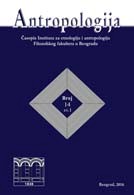ARCHITECTURE AT SAN BARTOLO, EL PETEN,
GUATEMALA: OBJECT AND SUBJECT
ARCHITECTURE AT SAN BARTOLO, EL PETEN,
GUATEMALA: OBJECT AND SUBJECT
Author(s): Sanja SavkićSubject(s): Architecture, Cultural Anthropology / Ethnology
Published by: Институт за етнологију и антропологију
Keywords: San Bartolo; Maya architecture, existential status of images; mountaincave complex; quatrefoil motif;
Summary/Abstract: Certain ancient Maya architectural patterns had multiple meanings and symbolic functions. They were designed not simply as static monuments to demonstrate the power of their patrons, but as places for the performance of transcendent events that linked those rulers to their constituencies – ancestors and gods likewise. Moreover, when ritually activated, they could acquire existential status, by providing the object with agency, meaning, and its own point of view, thus annulling the subject- object dichotomy, which is in accordance with the magical-mythic beliefs of their makers. At San Bartolo, located in the north-east of the Guatemalan state El Peten, around the year 100 BC there was an architectural complex that incarnated some Maya ideas regarding the universe, its cosmogony, and the role of the human beings.
Journal: Antropologija
- Issue Year: 14/2014
- Issue No: 1
- Page Range: 79-95
- Page Count: 17
- Language: English

